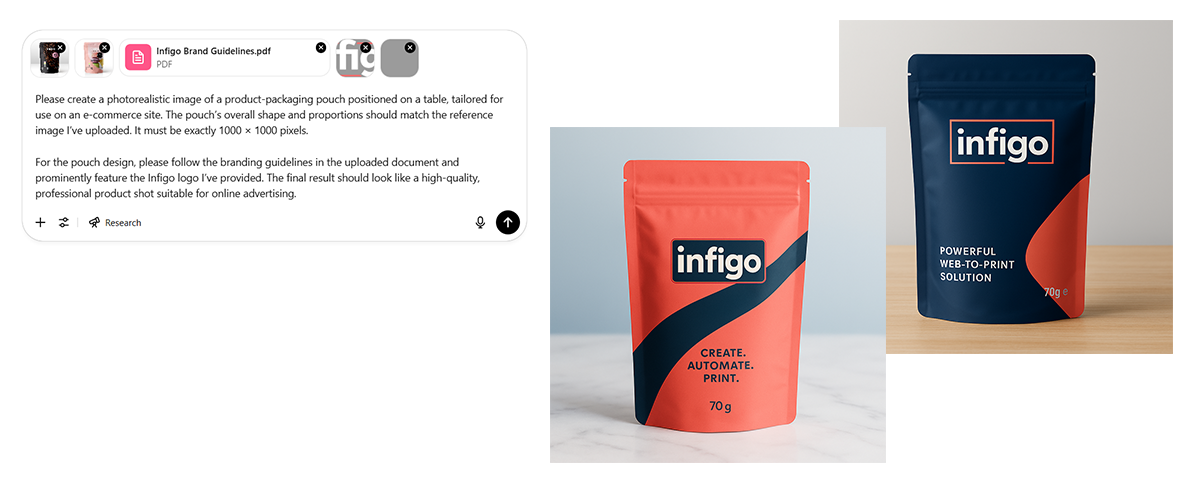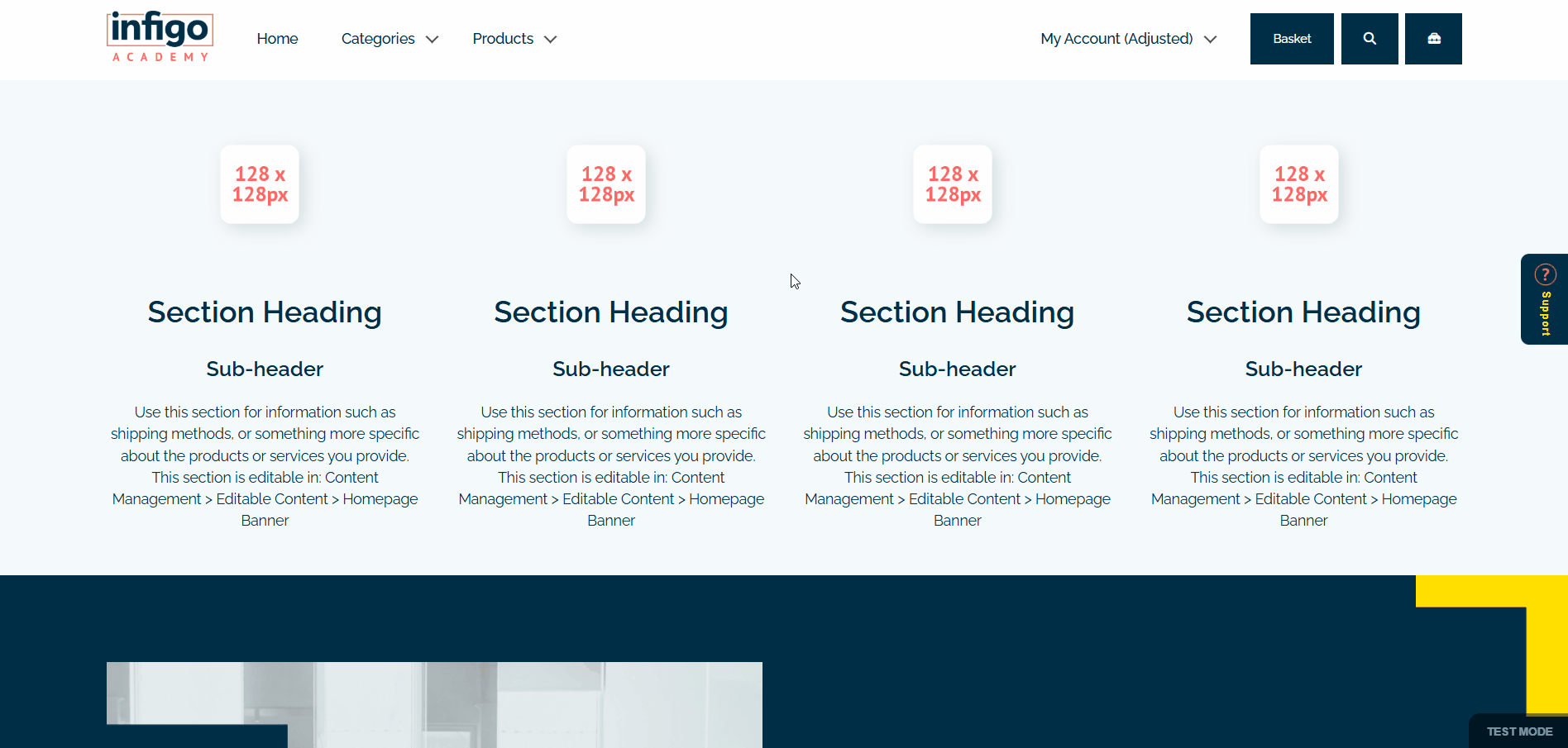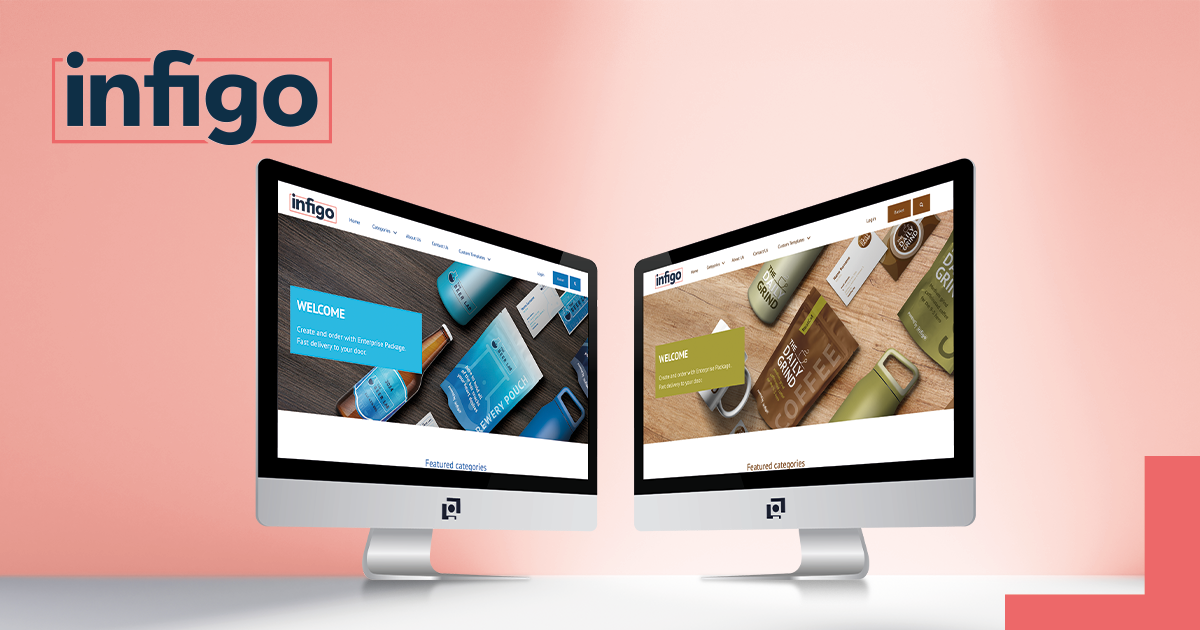Everyone is aware of the AI revolution. By this point, it’s simply impossible to ignore it. It’s here to stay, and businesses who don’t adapt are at serious risk of falling behind those who do. Mainstream AI tools are reshaping how print businesses operate. Here, we’ll take a detailed look at how readily available AI tools can supercharge many areas of your business, both print related and far, far beyond!
Whilst the average print business might consider their work to be largely ‘analogue’ in nature, it’s crucial to consider faster, more adaptive and more technologically advanced ‘digital’ approaches. Within the print industry, a large portion of this hyper-modernisation comes in the way of web-to-print. These e-commerce solutions offer you the means of expanding your operations online, automating your workflow and providing your customers with an elegant but simple user experience on custom-built storefronts. Ultimately, these solutions give you higher efficiency, productivity and profits.
Whilst top web-to-print providers such as Infigo are making inroads into incorporating AI into various elements of our software, it’s critically important to note just how beneficial low-cost mainstream tools such as Open AI’s ChatGPT, Google Gemini or Microsoft Co-Pilot can be. Copywriting, image generation, coding, data analysis, general troubleshooting, market research, and much, much more can all be handled to various degrees by these world-changing tools.
So, before we delve into each of these areas and how exactly it could revolutionise your print business, I want to clarify my position on the use of AI. It is not, and should never be, a full replacement for human ingenuity, skill and adaptability. That human touch is an absolute necessity. What AI tools are, is a highly intelligent and incredibly quick personal assistant, adept at an extraordinary array of tasks. Give it clear, comprehensive instructions and it will provide you with astounding results in a matter of seconds. To put it another way, my background is one of customer training, however with the assistance of AI tools I’ve successfully been able to achieve many of my goals in all of the aforementioned areas, even if they sit far outside of my skillset.
Now, with that out of the way, let’s take a peek at how you can incorporate low-cost AI-powered elements into your business in a way that will result in instant impact.
Best AI Prompting Techniques for Print Companies
If there’s one thing you take away from this article, it should be this solitary point; you get out of AI tools what you put in to them. It’s not Google search. Type something like “packaging pouch product description” into an AI tool and you’re very likely to get an equally uninspired response back. Detailed queries – or ‘prompts’ – are the key to maximising effectiveness of AI for print businesses. Make them detailed, clear, concise and provide as much context as you’re able to provide! It’s possible you’re wondering what these detailed prompts look like. We’ve got you covered with a few examples as we progress through this article.
Another useful kernel of knowledge is that there are often different language models available within each AI package. Whilst some simply seem to offer different ratios of speed / response quality, some of these models specialise in different technical areas. For example, you’ll find many models that specialise in writing, coding or advanced visual reasoning. By selecting the appropriate model to your task, you’ll gain a far more effective response.
Bring your Product Images to life with AI
Now to the topic that will pack the most visual punch, AI’s ability to generate brand new images from text prompts. Open AI’s DALL-E arguably reigns supreme here, but there are many other image generation models available.
Once again, effective prompting is key. However, many AI models will also let you provide additional input to assist with your query. This could include:
- Branding guideline documents
- Reference images that have a similar visual style
- Logo and other branding material
By combining all of these elements into one single prompt, you can get some truly stunning results.
 Prompt Example:
Prompt Example:
“Please create a photorealistic image of a product-packaging pouch positioned on a table, tailored for use on an e-commerce site.
The pouch’s overall shape and proportions should match the reference image I’ve uploaded. It must be exactly 1000 × 1000 pixels.
For the pouch design, please follow the branding guidelines in the uploaded document and prominently feature the Infigo logo I’ve provided.
The final result should look like a high-quality, professional product shot suitable for online advertising.”
Documentation included with the prompt: Infigo brand guidelines, several reference images, logo file.
How AI Can Help Print Shops Create Better Website Content
Probably one of the most common use cases for popular AI models. AI language models are incredibly adept at taking large volumes of written information and making visually pleasing, flowing bodies of text which are consice, well structured and (for the most part) accurate.
One thing AI language models do struggle with is sounding, well, human! We’ve all read emails, articles are blog posts which just scream “robot”, and this is something that you need to consider carefully if using AI for the creation of written content. By all means utilise this resource, you would be crazy not to, but I would highly recommend using it as a drafting or sanity-checking tool. Everything the AI model produces should be checked for technical accuracy and for a writing style that suits your brand.
With these considerations in mind, you could use AI language models to:
- Write a first draft of product details, home page content or blog posts
- Sanity-check your written content for spelling, grammar, technical accuracy, structure and writing style
Looking at prompt examples for this section, let’s take a peek behind the curtain at how I used these tools to assist in the initial ideas and refinement stages of this very article:
“I need several SEO-friendly article ideas for Infigo’s blog that appeal to print shops and decision-makers in web-to-print.
Give me a broad spectrum of ideas so I can make an informed decision on which one to choose, or perform additional research.For each idea, give me a clear title, a one-sentence summary of what the article would cover, and then describe in a few sentences how the article would flow—from introduction to key sections to conclusion.
I also need you to present why the idea would make a good blog post and how it is relevant to our target audience. Ensure you perform research on the web in order to get context for your response. Present any sources you have used so I can use them for further research.”
“I will present you with a draft article which will be submitted as a blog post on Infigo’s website (https://www.infigo.net). Review my draft article and give me detailed feedback on its contents.
Consider: Grammar, spelling, Is it factual? Is it technically accurate? Does it have a good structure? Is it well written in clear, concise language?
Do not rewrite it for me, just provide detailed critique and suggest ways it could be further improved. Additionally, search the web and present me with sources against which I can cross-check the information I’ve presented. Here’s my draft article: [Insert article text]”
“I will provide you with my completed article, currently presented in plain text format. Format the text so that it is easily readable and presented in a modern way, suitable for a web based blog post.
For the areas where I’ve placed example prompts, ensure they are visually distinct from the rest of the article. Present your output in both rich text format and html. Do not change the written content of the article in any way. Here’s my article: [Insert article text]”
Customising Sites Without a Developer
I’m not a web developer or computer programmer in any way, shape or form. Frankly, I’m impressed with myself if I get an Excel formula to work, never mind a complex body of HTML. Fortunately for me, AI language models (some of which specialise in code) are particularly adept at generating accurate code from a simple text based idea.
You might be asking, how is it that we can use this in our web-to-print scenario? Platforms like Infigo have full teams of software developers, in addition to specialist web development staff who excel at these incredibly complex tasks.
On this note let me be clear. If you want a polished web-to-print storefront with a world-class user experience (beyond what’s possible with our user-friendly Content Templates), supported by a second-to-none software back-end, then you’re going to need the help of our professionals! However, if you’re looking to make quick, creative tweaks to the look and feel of your sites or create something just a little bit customised, then AI could be your absolute best friend.
Let’s take a look at an example:
“I need you to write the code which creates a small tab that will appear to the right of the screen. It should be unobtrusive but should capture the attention. It should contain a small version of the image below: /-1544854870/Handler/CSSOverride/GetImage/118/question icon.png This image is of a coral coloured question mark.
Include the words “Support” on the tab somewhere, but again, it needs to be unobtrusive.
All of this needs to be adaptive to different screen sizes.Stick to the main colour palette of my site. Colour palette: Navy RGB 0 / 46 / 71 #002E47 Coral RBG 255 / 104 / 103 #FF6867 Place blue RGB 152 / 193 / 217 #98C1D9 Purple RBG 67 /68 /162 #4344A2 Yellow RGB 255 / 224 / 0 #FFE000 Blue RGB 52 / 131 / 172 #3483AC Secondary coral RGB 255 / 168 / 155 #FFA89B Light blue RBG 202 / 223 / 235 #CADFEB Light pink RGB 255 / 210 / 204 #FFD2CC
When the tab is clicked, a stylised pop up should appear which greys out the background. When the background is clicked, the pop up should go away. Once they do this the small tab should also disappear.
The pop up should explain the different support options available with opening times (9am-6pm Mon-Fri), phone number (use a placeholder), email (use a placeholder) and button with the text “Get in Touch” which links to the Contact Us page (https://academy.infigo.net/t/contactus) You can get a bit more creative with these descriptions.Your response should use JS, CSS and HTML only. Put it in a format I can copy/paste into an embed on my page. Include a large amount of notes to the code in case I need to adjust things later (I’m not a software developer)”

Making Print Reports Easier to Read and Act On
Websites are capable of gathering a mountain of data points which, if used correctly, can provide valuable insight into how every inch of your site is performing and allow you to make informed decisions to improve effectiveness even further. The problem is, where do we start? We may have this garbled mass of data, but how do we turn it into something we can understand and actually act upon?
By this point, you won’t be surprised by my answer. AI doesn’t just have to be a tool for creating new content for your websites, it’s also a brilliant tool for re-organising and presenting data in a human-readable and friendly way. “Analyse this data and create a graph“, “Construct a report based on the provided data” and “Present a detailed table using this data” are all perfectly valid starts to your prompts. This is, of course, if you stick to the golden rules we discussed earlier on!
For my example however, I want to deviate from this a little and venture into even more powerful data analytics. Infigo provide a module called Infigo Insights, which utilises the Metabase platform to provide comprehensive, platform-wide reporting tools. Now, whilst Metabase has fantastic report building tools for those not fluent in SQL (a well known language for accessing and manipulating databases), why don’t we use our friendly AI tools to construct the SQL for us?
We can get complex data structures far quicker and easier than if we were constructing it manually. In addition, you may skip the requirement to tackle that initial learning curve on the reporting tools, saving even more time.
It’s outrageously simple, really. Just provide the AI tools with a heap of copy/pasted data on available data points and tell it exactly the data you need output, along with the format in which you require it. Let’s take a look at a prompt and output from the Infigo Academy reporting tools, which also utilises Metabase. We’ll just gather an assortment of information and calculated metrics to demonstrate the potential power this gives us:
“I need assistance creating SQL code to format data in a table. Below, I will provide information on all relevant data points for your reference when constructing this code, these are applicable to my specific application.
You must provide your output in a complete format where I can just copy and paste it into an area expecting SQL code input.
Using this data, provide an output for me which shows the following data:
The top 5 viewed (or quoted) products.
Organise it so the most viewed is at the top of the list.
Show the product name
Show many times the product has been viewed in the last 30 days
Show me the amount of time (in days) it has been since the product was last viewed
The first name of the last user to view the product
Create a metric displaying the trend of views for each of these products. Looking at each day for the last 30 days, is the amount of views “Increasing”, “Decreasing” or “Static”.Give each of these columns short, appropriate names. Maintain the filter of storefront 23 in your output. If the name of the last viewer is blank or null, replace it with the word “Guest” instead
Here is the data point information for you to reference: SELECT TOP(1048575) “reporting”.”quote”.”id” AS “id”, “reporting”.”quote”.”name” AS “name”, “reporting”.”quote”.”status” AS “status”, “reporting”.”quote”.”markup_type” AS “markup_type”, [Data continues….]
And below is the result, in a matter of seconds. This is now a reusable table I can look at at any time to get up to date data!

How AI Simplifies Market Research for Print Companies
Gone are the days when market research needs to be a time intensive, laborious (and potentially very expensive) task. Many of the mainstream AI providers give their models the ability to search the open internet. This is an incredibly powerful tool which allows us to fetch live online data from multiple sources with a single prompt. Whilst we still need to be careful with the accuracy of AI’s output and double-check the information it has provided, it’s happy to quickly perform the legwork for you and gather a whole bunch of resources for you. In addition, within the same prompt it can compare the data it has found, ask the solution to provide arguments and give recommended courses of action.
Let’s take a look at an example prompt, while also giving you a head start in deciding which AI solution you might want to choose!
“Perform detailed market research for me. I want to compare the different mainstream AI solutions available on the market. You MUST extensively search the web and compare many different sources. Clearly provide information on your sources, so I can verify the information you give to me.
Tasks I will want to accomplish using the AI solutions include:
Image generation, copywriting, coding, data analysis and market research.
This is not a complete list, but compare metrics such as:
Cost, accuracy, ongoing updates, reputation of provider, privacy policies, effectiveness in each of the areas mentioned previously, means of access (desktop, mobile app, api, etc).
I will use your output to inform my decision on which AI solution may be best for my particular use cases. For context, I am currently writing a comprehensive blog article covering the use of low-cost mainstream AI models to supercharge print businesses.”
You can view the AI generated report here.
Get Started with AI and Web-to-Print Today
Well, there you have it. A comprehensive guide to get you started with incorporating cheap, effective AI solutions into your print business!
The ways in which common AI tools can help us improve our business practices is a list which continues to grow and grow as the technology develops. It’s worth dedicating at least a little time to keeping up to speed with the latest developments in this technology which is already changing the world as we know it. As far as print is concerned, the biggest gains with mainstream AI come in the form of your online web-to-print offerings.
AI is here. It’s not going away. It’s simply a matter of whether you’re ready, willing and able to get on board. Contact Infigo today to see how our web-to-print solution can help unlock the full potential of AI for print businesses.




